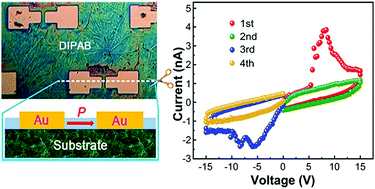Self-assembled non-volatile micro memory arrays of molecular ferroelectrics†
Abstract
Numerous molecular ferroelectrics having excellent properties even comparable to inorganic ones, which usually contain heavy or toxic metals, have been developed recently. Hopefully, they can be used as substitutes for the well-known organic ferroelectric polymers (P(VDF-TrFE)) with huge coercive fields and poor spontaneous polarization for various applications. However, the bottleneck for practical applications, i.e., the preparation of high-quality thin films and high resolution device arrays with a desired crystallographic orientation for memory switching, still remains. In this study, large-area micro device arrays of molecular ferroelectrics with highly-crystalline or even single-crystalline films are intentionally self-assembled on electrodes or within electrode gaps using a solution processing technique, including the molecular ferroelectrics for which it is usually difficult to make thin films. The as-grown air-stable memory micro arrays with an optimum crystallographic orientation can exhibit excellent non-volatile memory performance with a smaller operation voltage of <5 V. These attributes can pave the way for molecular ferroelectrics to become a promising candidate for applications including flexible memories and circuits.



 Please wait while we load your content...
Please wait while we load your content...